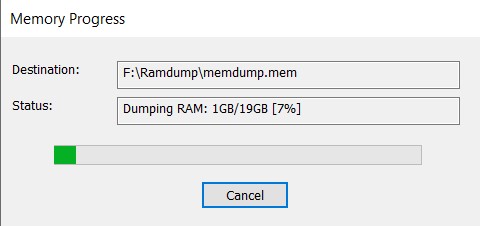The content of this post is solely the responsibility of the author. AT&T does not adopt or endorse any of the views, positions, or information provided by the author in this article.
In the realm of digital forensics and incident response, the analysis of volatile memory, commonly referred to as RAM (Random Access Memory), plays a pivotal role in extracting crucial evidence and uncovering valuable information. RAM dump - the process of capturing the contents of a computer's memory, is a vital step in preserving volatile data for forensic examination. This article aims to shed light on the importance of RAM dump in digital investigations and provide insights into the process involved.
The significance of RAM dump
- Volatile nature of RAM: RAM is a volatile form of memory that holds data temporarily while a computer is powered on. Once the system is shut down, the contents of RAM are lost. Therefore, capturing a RAM dump becomes essential to preserve valuable evidence that may not be available through traditional disk-based analysis.
- Dynamic and live information: RAM contains real-time information about running processes, active network connections, open files, encryption keys, passwords, and other critical artifacts. Analyzing the RAM dump allows forensic investigators to access this dynamic and live information, providing insights into the state of the system at the time of the incident.
- Uncovering hidden or encrypted data: RAM often holds data that may not be easily accessible through traditional file system analysis. It can reveal information about active malware, hidden processes, encrypted data in memory, or remnants of deleted files, offering a wealth of evidence that can be crucial to an investigation.
The RAM dump process
- Acquiring a RAM dump: To perform a RAM dump, specialized tools or techniques are used to capture the contents of RAM. Common methods include physical access and utilizing software tools designed for memory acquisition. Physical access allows directly connecting to the computer's memory modules, while software tools can acquire RAM remotely or by creating a memory image from a hibernation file.
- Preserving data integrity: It is essential to ensure the integrity of the RAM dump during acquisition to maintain its evidentiary value. This involves utilizing write-blocking mechanisms, verifying the integrity of the acquired image, and documenting the entire process to establish a proper chain of custody.
- Analyzing the RAM dump: Once the RAM dump is acquired, it can be analyzed using specialized software tools designed for memory forensics. These tools enable investigators to extract information, identify running processes, recover artifacts, and search for patterns or indicators of compromise.
- Extracting volatile data: The RAM dump analysis involves extracting volatile data such as active network connections, running processes, loaded drivers, registry information, file handles, and other artifacts. This data can be used to reconstruct the system's state, identify malicious activities, or uncover hidden information.
- Memory carving and artifacts recovery: Memory carving techniques are employed to search for specific file types or artifacts within the RAM dump. This process involves identifying file headers or signatures and reconstructing files from the memory image. This can be particularly useful in recovering deleted or encrypted files.
RAM dumps can be acquired using specialised tools like FTK Imager and Magnet Ram Capturer (both of which are available for free) or the analysis can be done using specialised tools or Open source frameworks like Volatility Framework.
Let’s take a look on how to acquire a RAM dump and registry files using FTK Imager.
To acquire RAM and registry files, please follow these steps:
- Download FTK imager from here.
- Follow the installation steps.
- Once installed, Run FTK imager and select Capture memory option from toolbar menu as shown in screenshot:
Alternatively, you can select Capture memory from the File dropdown menu inside FTK Imager as illustrated in screenshot below:
Once you select Capture memory, provide a destination path where you wish to save the dump file. Alternatively, you can select to include pagefile. After that, the process of capturing memory will begin.
You will receive a pop up once the process is finished.
Since I chose to capture memory as well as pagefile I will have two files available.
The file with the name “memdump.mem” is the RAM capture file.
You can take the dump file to analyze as required on your forensics workstation.
Best practices and considerations
- Timeliness and live analysis: RAM dump acquisition should be performed as soon as possible to capture the volatile data before it gets overwritten or lost. Additionally, live analysis of the RAM dump can provide real-time insights into ongoing activities and help mitigate immediate threats.
- Privacy and legal considerations: Collecting and analyzing a RAM dump may involve accessing sensitive user data or private information. It is crucial to follow legal procedures, obtain proper authorization, and adhere to privacy laws and regulations to ensure compliance and protect the rights of individuals involved.
- Proper training and expertise: RAM analysis requires specialized knowledge and skills in memory forensics. Forensic investigators should undergo proper training and continuously update their expertise to effectively handle RAM dump acquisition and analysis.
Conclusion
RAM dump acquisition and analysis are vital components of digital forensics and incident response investigations. The volatile nature of RAM and the real-time information it holds make RAM dump an invaluable source of evidence. By understanding the importance of RAM dump and following proper acquisition and analysis procedures, forensic investigators can uncover hidden data, identify malicious activities, and reconstruct the system's state during an incident.
However, it is essential to stay updated with evolving technologies, legal considerations, and best practices in RAM analysis to ensure the integrity and effectiveness of the process. Ultimately, RAM dump plays a critical role in modern digital investigations, helping investigators piece together the puzzle and provide essential insights for resolving cases.




